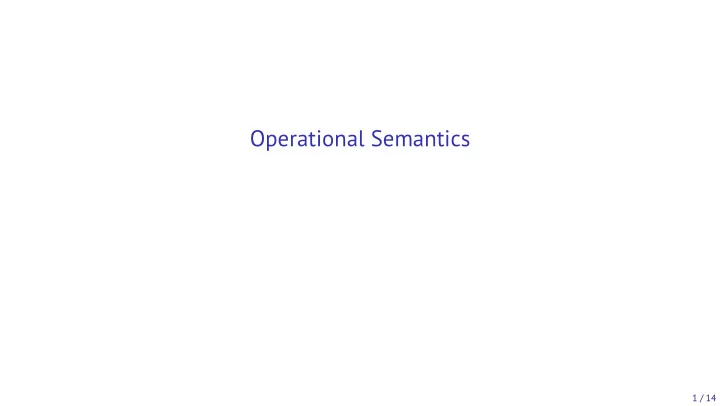

Operational Semantics 1 / 14
Outline What is semantics? Operational Semantics What is semantics? 2 / 14
What is the meaning of a program? Recall: aspects of a language • syntax : the structure of its programs • semantics : the meaning of its programs What is semantics? 3 / 14
How to define the meaning of a program? Formal specifications • denotational semantics : relates terms directly to values • operational semantics : describes how to evaluate a term • axiomatic semantics : describes the effects of evaluating a term • ... Informal/non-specifications • reference implementation : execute/compile program in some implementation • community/designer intuition : how people think a program should behave What is semantics? 4 / 14
Advantages of a formal semantics A formal semantics ... • is simpler than an implementation, more precise than intuition • can answer: is this implementation correct? • supports the definition of analyses and transformations • prove properties about the language • prove properties about programs written in the language • promotes better language design • better understand impact of design decisions • apply semantic insights to improve the language design (e.g. compositionality ) What is semantics? 5 / 14
Outline What is semantics? Operational Semantics Operational Semantics 6 / 14
What is operational semantics? Defines the meaning of a program by describing how it is evaluated General strategy 1. identify machine state : the state of evaluation • sometimes just the term being evaluated 2. define the machine transitions : relates old states to new states • typically using inference rules 3. define semantics in terms of machine transitions (this part is trivial) Operational Semantics 7 / 14
Two styles of operational semantics Natural semantics (a.k.a. big-step semantics) • define transition relation ( ⇓ ) representing evaluation to a final state • semantics is this relation directly Structural operational semantics (a.k.a. small-step semantics) • define transition relation ( �→ ) representing one step of evaluation • semantics is the reflexive, transitive closure of this relation ( �→ ∗ ) Argument for structural operational semantics: + reason about intermediate steps + systematic type soundness proof + reason about incomplete derivations – a bit more complicated Operational Semantics 8 / 14
Natural semantics example Define one-step evaluation relation e ∈ Exp true ::= Step 1. identify final states: { true , false } | false | not e Step 2. define evaluation relation: | if e e e e ⇓ e ⊆ Exp × { true , false } Definition: e ⇓ e ⊆ Exp × { true , false } e ⇓ true e ⇓ false Not-T Not-F true ⇓ true false ⇓ false not e ⇓ false not e ⇓ true e 2 ⇓ e ′ e 3 ⇓ e ′ If-T e 1 ⇓ true If-F e 1 ⇓ false if e 1 e 2 e 3 ⇓ e ′ if e 1 e 2 e 3 ⇓ e ′ Operational Semantics 9 / 14
Structural operational semantics example Define one-step evaluation relation e ∈ Exp true ::= Step 1. identify machine state: Exp | false | not e Step 2. define transition relation: e �→ e ′ ⊆ Exp × Exp | if e e e Definition: e �→ e ′ ⊆ Exp × Exp not true �→ false not false �→ true � reduction rules how to evaluate if true e 2 e 3 �→ e 2 if false e 2 e 3 �→ e 3 e �→ e ′ e �→ e ′ � congruence rules Not If if e e 2 e 3 �→ if e ′ e 2 e 3 not e �→ not e ′ where to evaluate Operational Semantics 10 / 14
Defining the one-step transition Terminology: • reduction rule : replaces an expression by a “simpler” expression • redex (reducible expression): an expression that matches a reduction rule • congruence rule : describes where to find the next redex • value : a final state, has no more redexes (e.g. true or false ) Observations: • No rules for values – nothing left to do! • Congruence rules define the order of evaluation • The meaning of a term is the sequence of steps that reduce it to a final state Operational Semantics 11 / 14
Completion of the semantics Semantics : the reflexive, transitive closure of the one-step transition judgment Step 3. Define the judgment ( �→ ∗ ) as follows • just replace state by your machine state • this last step is the same for any structural operational semantics! Definition: s �→ ∗ s ′ ⊆ state × state s ′ �→ ∗ s ′′ Trans s �→ s ′ Refl s �→ ∗ s s �→ ∗ s ′′ Operational Semantics 12 / 14
Full definition of the Boolean language Definition: e �→ e ′ ⊆ Exp × Exp e ∈ Exp true ::= | false not true �→ false not false �→ true | not e | if e e e if true e 2 e 3 �→ e 2 if false e 2 e 3 �→ e 3 e �→ e ′ e �→ e ′ Not If if e e 2 e 3 �→ if e ′ e 2 e 3 not e �→ not e ′ Definition: e �→ ∗ e ′ ⊆ Exp × Exp e ′ �→ ∗ e ′′ Trans e �→ e ′ Refl e �→ ∗ e e �→ ∗ e ′′ Operational Semantics 13 / 14
Reduction sequences Reduction sequence Shows the sequence of states after each application of a reduction rule • congruence rules indicate where to find next redex (underline) • reduction rules indicate how to reduce it Example reduction sequence if (not true) (not false) (if true (not true) false) �→ if false (not false) (if true (not true) false) �→ if true (not true) false �→ not true �→ false Operational Semantics 14 / 14
Recommend
More recommend